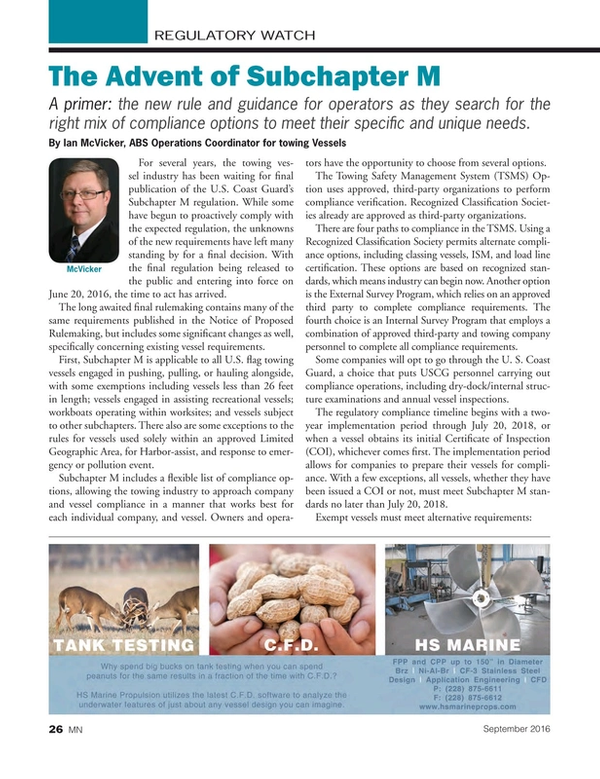
The Advent of Subchapter M
By Ian McVicker
A primer: the new rule and guidance for operators as they search for the right mix of compliance options to meet their specific and unique needs.
For several years, the towing vessel industry has been waiting for final publication of the U.S. Coast Guard’s Subchapter M regulation. While some have begun to proactively comply with the expected regulation, the unknowns of the new requirements have left many standing by for a final decision. With the final regulation being released to the public and entering into force on June 20, 2016, the time to act has arrived.
The long awaited final rulemaking contains many of the same requirements published in the Notice of Proposed Rulemaking, but includes some significant changes as well, specifically concerning existing vessel requirements.
First, Subchapter M is applicable to all U.S. flag towing vessels engaged in pushing, pulling, or hauling alongside, with some exemptions including vessels less than 26 feet in length; vessels engaged in assisting recreational vessels; workboats operating within worksites; and vessels subject to other subchapters. There also are some exceptions to the rules for vessels used solely within an approved Limited Geographic Area, for Harbor-assist, and response to emergency or pollution event.
Subchapter M includes a flexible list of compliance options, allowing the towing industry to approach company and vessel compliance in a manner that works best for each individual company, and vessel. Owners and operators have the opportunity to choose from several options.
The Towing Safety Management System (TSMS) Option uses approved, third-party organizations to perform compliance verification. Recognized Classification Societies already are approved as third-party organizations.
There are four paths to compliance in the TSMS. Using a Recognized Classification Society permits alternate compliance options, including classing vessels, ISM, and load line certification. These options are based on recognized standards, which means industry can begin now. Another option is the External Survey Program, which relies on an approved third party to complete compliance requirements. The fourth choice is an Internal Survey Program that employs a combination of approved third-party and towing company personnel to complete all compliance requirements.
Some companies will opt to go through the U. S. Coast Guard, a choice that puts USCG personnel carrying out compliance operations, including dry-dock/internal structure examinations and annual vessel inspections.
The regulatory compliance timeline begins with a two-year implementation period through July 20, 2018, or when a vessel obtains its initial Certificate of Inspection (COI), whichever comes first. The implementation period allows for companies to prepare their vessels for compliance. With a few exceptions, all vessels, whether they have been issued a COI or not, must meet Subchapter M standards no later than July 20, 2018.
Exempt vessels must meet alternative requirements:
- Towing vessels must meet Watertight and Weathertight Integrity standards by July 20, 2016;
- New Installations not “Replacements in Kind” made after July 20, 2016, must perform a Verification of Compliance with Design Standards, meeting the requirements for “New Vessels;”
- Major Conversions must perform a Verification of Compliance with Design Standards, meeting the requirements for “New Vessels;”
- New Towing Vessels, those with a “keel laid” date after July 20, 2017, must obtain a COI before entering service.
The regulations include a compliance phase-in period, allowing industry to complete the required dry-dock examinations, and the Coast Guard to inspect and issue vessel COI’s. The owner or operator has five years from the date the COI is issued to complete any delayed implementation requirements. The compliance phase-in dates are:
- July 22, 2019 – 25% of fleet;
- July 20, 2020 – 50% of fleet;
- July 19, 2021 – 75% of fleet;
- July 19, 2022 – 100% of fleet;
- Companies using the TSMS option must have a Safety Management System Certificate in place on a vessel for at least six months before the vessel can be issued a COI.
Many changes were made in the final rule for existing towing vessels as it pertains to Machinery and Electrical Systems and Equipment. The proposed rulemaking, Part 143 contained two sections addressing “deferred machinery” requirements for vessels. In the final rule publication, these two sections were removed, and most requirements contained moved to “New Vessels Only” requirements. Existing towing vessels now only have two delayed implementation engineering requirements for Towing Machinery and the Pilothouse Alert System. The Pilothouse Alert System will only be required on vessels greater than 65 feet.
One thing is for certain as organizations begin to take the steps to comply with the final rule, no one size fits all solution exists. It is important for organizations, regardless of size, to make sure they find the right mix of compliance options to meet their specific and unique needs.
The Author
Ian McVicker is ABS Operations Coordinator for towing Vessels.
(As published in the September 2016 edition of Marine News)
Read The Advent of Subchapter M in Pdf, Flash or Html5 edition of September 2016 Marine News
Other stories from September 2016 issue
Content
- Interview: Aaron Smith Zeroes in on the Offshore Sector page: 12
- 'A Few Good Men' Thanks for the Leadership! page: 18
- Rethinking Inland Infrastructure Finance page: 20
- US Boatbuilding: Sink or Swim page: 24
- The Advent of Subchapter M page: 26
- Subchapter M: Post Publication Highlights page: 28
- Sustainable (R)Evolution: A Multipurpose Maritime Education Fleet page: 30
- Avalon Freight Services Redefines the Shortsea Shipping Formula page: 36
- CARB Powers Clean Air in California page: 40
- Why Should I Care About Thermal Insulation? page: 44
- Shipyard Productivity Reaches New Heights page: 48


